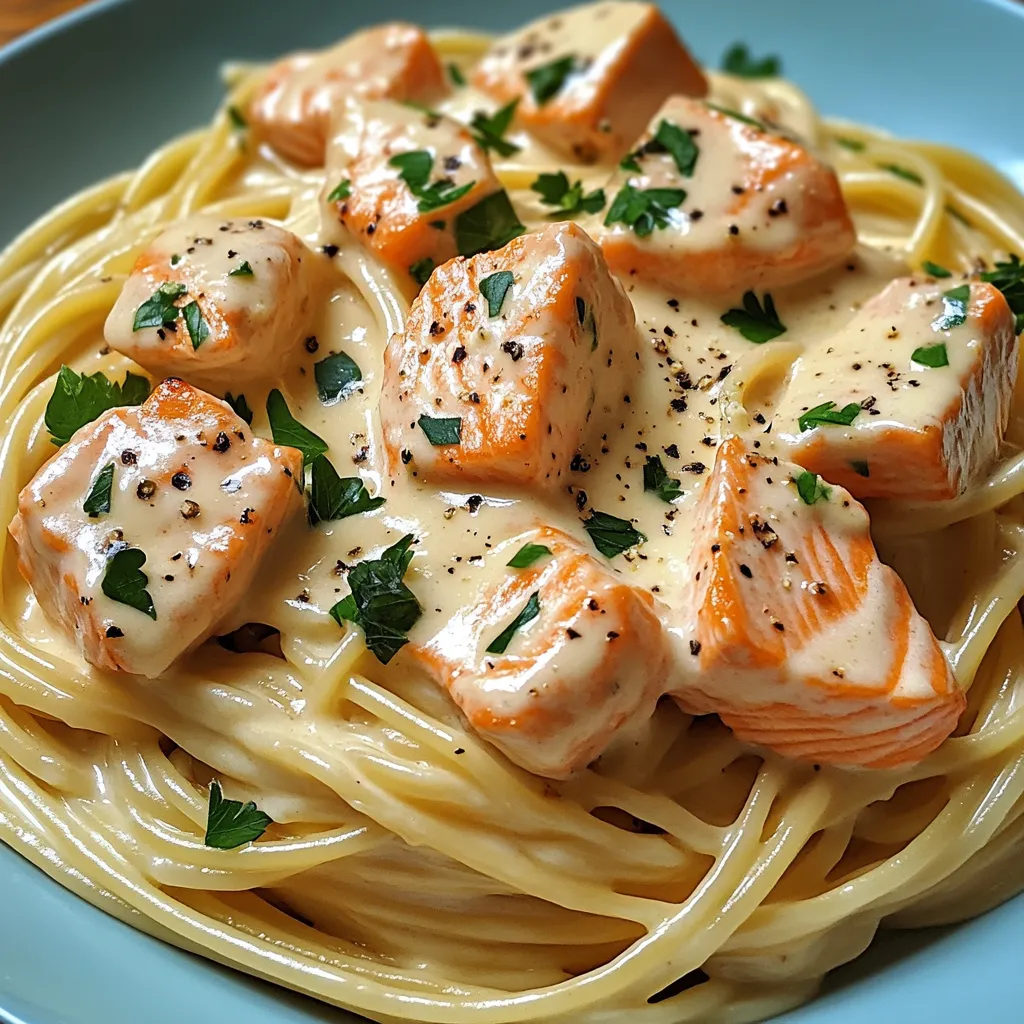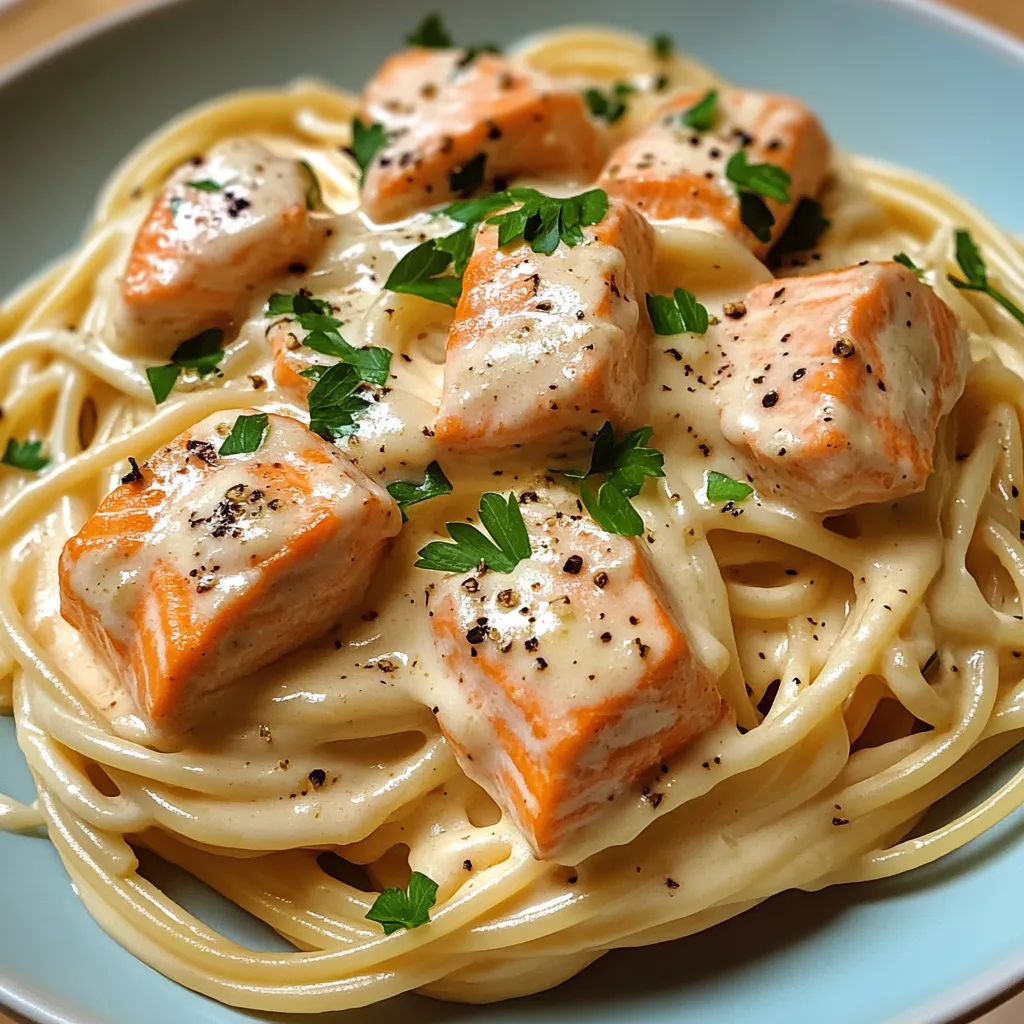 Save
Save
Silky strands of pasta intertwine with tender flakes of salmon, all embraced by a velvety garlic cream sauce that clings perfectly to every bite. This indulgent yet surprisingly simple dish transforms everyday ingredients into something truly special, creating a restaurant-quality meal right in your own kitchen. The gentle pop of lemon brightens the richness while fresh herbs add color and complexity to this elegant comfort food creation.
I first made this recipe when trying to recreate a memorable dish from a seaside Italian restaurant I visited years ago. The combination of flavors instantly transported me back to that evening, and it's since become my go-to impressive dinner that never fails to delight guests. My husband, who typically prefers meat over seafood, requests this pasta regularly, and my daughter, who used to push salmon around her plate, now eagerly helps prepare it. There's something magical about how the cream sauce mellows the salmon's richness while the garlic adds depth without overpowering.
Flavor Building Blocks
- Fresh Salmon Fillets: Choose bright, firm fillets with vibrant color for the best flavor—wild-caught varieties offer more pronounced flavor while farm-raised tends to be milder and more buttery
- Pasta Selection: Long pasta shapes like linguine or fettuccine catch and hold the silky sauce perfectly—fresh pasta creates an elevated experience but high-quality dried works beautifully
- Heavy Cream: Creates the luxurious base that transforms this dish from ordinary to extraordinary—its high fat content ensures a stable sauce that won't break when simmered
- Fresh Garlic: Aromatic foundation that perfumes the entire dish—mincing it finely ensures it distributes evenly and cooks quickly without burning
- Fresh Lemon: Brightens the rich sauce with essential acidity that cuts through creaminess—using both juice and zest captures the fruit's full flavor spectrum
- Parmesan Cheese: Adds savory depth and helps thicken the sauce—freshly grated melts seamlessly into the cream unlike pre-packaged varieties
- Fresh Herbs: Parsley adds color and brightness while complementing the seafood perfectly—chopping just before serving preserves its vibrant flavor
Perfect Preparation
- Season The Salmon:
- Pat salmon fillets dry with paper towels to promote proper browning. Season generously with salt and freshly ground black pepper on both sides, allowing the seasonings to enhance the fish's natural flavor while creating a delicious crust when cooked.
- Create The Sear:
- Heat two tablespoons olive oil in a large non-stick skillet over medium-high heat until shimmering but not smoking. Place salmon skin-side down in the hot pan, pressing gently with a spatula to ensure even contact. Cook undisturbed for 4-5 minutes until the skin becomes crispy and golden.
- Finish The Fish:
- Carefully flip salmon and cook for another 2-3 minutes until just barely cooked through—the center should still be slightly translucent as it will continue cooking from residual heat. Remove to a plate and tent loosely with foil to rest while maintaining moisture.
- Cook The Pasta:
- While salmon cooks, bring a large pot of water to a rolling boil. Add a generous tablespoon of salt (the water should taste like the sea). Add 8 ounces of pasta and cook according to package directions until al dente, reserving one cup of starchy pasta water before draining.
- Build The Sauce Base:
- In the same skillet used for salmon, reduce heat to medium and add remaining tablespoon of olive oil. Add four minced garlic cloves and sauté for 30-45 seconds until fragrant but not browned, stirring constantly to prevent burning.
- Create The Silky Sauce:
- Pour in half cup of chicken broth and use a wooden spoon to scrape up any flavorful browned bits from cooking the salmon. Allow to simmer for 2 minutes until slightly reduced, then add half cup of heavy cream and continue simmering for 3-4 minutes until the sauce begins to thicken.
- Enhance The Flavor:
- Whisk in one tablespoon fresh lemon juice, half teaspoon lemon zest, and quarter cup grated Parmesan cheese until smooth and incorporated. Taste and adjust seasoning with salt and pepper, remembering that the salmon and pasta water will add additional saltiness.
- Combine The Elements:
- Flake the rested salmon into large chunks, discarding the skin if desired. Add drained pasta directly to the sauce, tossing gently with tongs while adding splashes of reserved pasta water as needed to achieve the perfect silky consistency that clings to the pasta strands.
 Save
Save
I learned the importance of pasta water from my Italian grandmother, who would swat my hand away whenever I tried to discard this 'liquid gold.' She taught me that the starchy water creates the perfect liaison between sauce and pasta, turning them from separate components into a cohesive dish. When I first made this recipe for my husband's birthday, I worried the salmon might overpower the delicate cream sauce. Instead, they complemented each other perfectly, with the garlic acting as the perfect bridge between flavors. Now whenever we want to celebrate something special without spending hours in the kitchen, this dish is our go-to solution.
Elegant Accompaniments
Transform this already impressive dish into a complete dining experience with carefully selected side dishes that complement without competing. Serve alongside roasted asparagus spears tossed with olive oil, sea salt, and a squeeze of lemon for a verdant companion that echoes the brightness in the pasta sauce. For a more substantial meal, add a simple arugula salad dressed with lemon vinaigrette and shaved Parmesan, creating a peppery contrast to the rich pasta. Crusty artisan bread makes the perfect vehicle for capturing every last drop of the delicious sauce. For special occasions, start with bruschetta topped with diced tomatoes and fresh basil to set the stage for the main course while maintaining the Italian flavor profile.
Creative Twists
Adapt this versatile dish to create new experiences while maintaining its elegant essence. Mediterranean version incorporates sun-dried tomatoes, artichoke hearts, and a sprinkle of capers for a briny punch that complements the salmon beautifully. Springtime variation adds fresh green peas and tender asparagus tips during the final minutes of cooking for seasonal freshness and color contrast. Herb-lover's dream incorporates a mixture of fresh dill, chives, and tarragon for a complex herbaceous profile that enhances the salmon's natural flavors. Spicy option adds crushed red pepper flakes to the garlic sauté step for a gentle heat that builds throughout the dish, creating exciting contrast to the rich cream sauce.
Storage Success
Preserve the luxury of this dish even when enjoying as leftovers with proper storage and reheating techniques. Store completely cooled pasta in airtight glass containers rather than plastic to prevent the salmon from imparting fishiness to the container. Refrigerate for up to two days, keeping in mind that seafood pasta dishes have a shorter refrigerated life than other leftovers. When reheating, place in a skillet over medium-low heat with a splash of cream or milk to restore the sauce's silky texture, stirring gently to prevent breaking the salmon into tiny pieces. For lunch portions, reheat gently in a microwave at 50% power with a damp paper towel covering the container to create steam that helps revitalize the sauce.
 Save
Save
This creamy garlic salmon pasta has become my signature dish for good reason. It strikes that perfect balance between impressive and achievable, creating a luxurious meal that doesn't require professional training or obscure ingredients. What I love most is how it transforms ordinary ingredients into something that feels special. The way the garlic-infused cream sauce coats each strand of pasta, the tender flakes of salmon adding richness and protein, and the bright pop of lemon bringing everything into perfect balance – it's comfort food elevated to an art form. Whether you're cooking for someone special or simply treating yourself, this dish delivers restaurant-quality results with home kitchen simplicity.
Common Questions About Cooking
- → Can I use leftover cooked salmon for this recipe?
- Absolutely! Leftover cooked salmon works perfectly in this dish. Simply flake it and add it at the end, just long enough to warm through without overcooking.
- → What can I substitute for heavy cream to make it lighter?
- You can use half-and-half, milk mixed with a bit of cornstarch, or even Greek yogurt for a lighter version. The sauce won't be quite as rich but will still be delicious.
- → Is there a dairy-free option for this pasta?
- Yes! Use coconut cream instead of heavy cream and skip the Parmesan cheese (or use a dairy-free alternative). The coconut adds a subtle sweetness that pairs surprisingly well with the salmon.
- → What type of pasta works best with this sauce?
- Long pasta shapes like linguine, fettuccine, or spaghetti work wonderfully as they catch the creamy sauce. However, shorter shapes like penne or fusilli are also good options that hold the sauce in their nooks and crannies.
- → Can I add vegetables to this dish?
- Definitely! Sautéed spinach, peas, asparagus, or cherry tomatoes make excellent additions. Add heartier vegetables when you're making the sauce, and more delicate ones like spinach just before serving.
- → How do I know when the salmon is cooked perfectly?
- Salmon is cooked when it easily flakes with a fork but is still slightly translucent in the center. For perfectly cooked salmon, look for an internal temperature of 125°F (52°C) for medium-rare or 145°F (63°C) for well-done.
